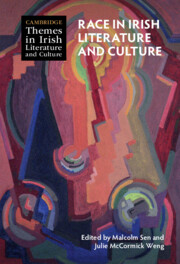Book contents
- Race in Irish Literature and Culture
- Cambridge Themes in Irish Literature and Culture
- Race in Irish Literature and Culture
- Copyright page
- Dedication
- Contents
- Figures
- Contributors
- Editors’ Note
- Introduction
- Chapter 1 “Our Heroic Ancestors”
- Chapter 2 Racializing Irish Historical Consciousness
- Chapter 3 Race, Minstrelsy, and the Irish Stage
- Chapter 4 Race and Irish Women’s Novels in the Long Nineteenth Century
- Chapter 5 Blackface Minstrelsy, Irish Modernism, and the Histories of Irish Whiteness
- Chapter 6 Joyce’s Racial Comedy
- Chapter 7 W. B. Yeats, the Irish Free State, and the Rhetoric of Race Suicide
- Chapter 8 “Ulster’s White Negroes”
- Chapter 9 Learning from Walcott
- Chapter 10 Race, Irishness, and Popular Culture in Australia
- Chapter 11 White Nationalism and Irish America
- Chapter 12 Diasporic Afterlives
- Chapter 13 “Dubh”
- Chapter 14 Split Selves and Double Consciousness in Recent Irish Fiction
- Chapter 15 Race, Place, and the Grounds of Irish Geopolitics
- Select Bibliography
- Index
- References
Select Bibliography
Published online by Cambridge University Press: 04 January 2024
- Race in Irish Literature and Culture
- Cambridge Themes in Irish Literature and Culture
- Race in Irish Literature and Culture
- Copyright page
- Dedication
- Contents
- Figures
- Contributors
- Editors’ Note
- Introduction
- Chapter 1 “Our Heroic Ancestors”
- Chapter 2 Racializing Irish Historical Consciousness
- Chapter 3 Race, Minstrelsy, and the Irish Stage
- Chapter 4 Race and Irish Women’s Novels in the Long Nineteenth Century
- Chapter 5 Blackface Minstrelsy, Irish Modernism, and the Histories of Irish Whiteness
- Chapter 6 Joyce’s Racial Comedy
- Chapter 7 W. B. Yeats, the Irish Free State, and the Rhetoric of Race Suicide
- Chapter 8 “Ulster’s White Negroes”
- Chapter 9 Learning from Walcott
- Chapter 10 Race, Irishness, and Popular Culture in Australia
- Chapter 11 White Nationalism and Irish America
- Chapter 12 Diasporic Afterlives
- Chapter 13 “Dubh”
- Chapter 14 Split Selves and Double Consciousness in Recent Irish Fiction
- Chapter 15 Race, Place, and the Grounds of Irish Geopolitics
- Select Bibliography
- Index
- References
- Type
- Chapter
- Information
- Race in Irish Literature and Culture , pp. 318 - 347Publisher: Cambridge University PressPrint publication year: 2024

